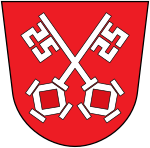Key Petri



The keys of Peter (also: papal keys) are the attribute of the apostle Peter as well as a symbol of the connective power of the Pope as the successor of Peter and representative of Jesus Christ on earth. Today they are mainly used as a heraldic element, for example in the papal coat of arms , in the coat of arms of the Vatican City and in the coat of arms of the Holy See (and with the latter also in the flag of the Vatican City ), but also in the coats of arms of various cities, dioceses, abbeys, etc., who have a special relationship with St. Peter.
Key handover iconography
The basis of the scenic representations in Christian art is the Bible passage Mt 16:19: “I want to give you the keys of the kingdom of heaven: What you will bind on earth should also be bound in heaven, and what you will loose on earth should also to be loosed in heaven ” in which Christ symbolically gives Simon Peter the sacramental power of binding and loosing after his confession of Caesarea in the circle of the other apostles . The earliest examples date back to the late Constantinian period in Rome. Until the Middle Ages, the motif was often accompanied by a representation of the passing of the law (traditio legis). Later, the handover is a popular image reproach in Italian Renaissance art (Perugino's fresco in the Sistine Chapel , 1481). Understandably, the topic gains importance in the Counter Reformation and its defense of the papal primacy ( Bernini 1649, Rubens 1615). In 1820 Ingres took up the subject again using Raffaelesque motifs.
Shape and symbolism of the individually shown keys
The key Petri as an independent symbol are usually reproduced in pairs, but as an attribute Petri they can also be shown individually. The beards often show a negative cross . Other beard shapes are also common; in rare cases, the beards are formed as the letters S and R, which as S acerdotium and R egnum (priesthood and power), as well as s olve et r etine (solvent and binder) is interpreted.
As far as they are used in direct connection with the Pope or the Holy See , it has been common practice since early modern times to represent a key each in the heraldic colors of gold and silver , whereby their position can differ depending on the purpose. The key bits are always on top, point downwards or outwards and have the aforementioned cross pattern. In addition, the keys are tied together with a red cord with tassels , the exact design of which also differs depending on the intended use.
There are different explanations for the meaning of this key symbol:
- Once the golden key can stand for the kingdom of heaven (“I will give you the keys of the kingdom of heaven;” ( Mt 16,19 EU )), while the silver key can stand for the earthly kingdom.
- The golden key symbolizes the power to bind and the silver key the power to redeem ("What you bind on earth should also be bound in heaven, and what you loosen on earth should also be loosened in heaven" ( Mt 16:19 EU )). The keys are then also referred to as tie and release keys.
- The golden key symbolizes the papal power to redeem (forgiveness of sins) and the silver one symbolizes the ban ray ( excommunication ).
Coat of arms of the Diocese of Belleville
See also
Web links
Individual evidence
- ↑ To this: Lexicon for Theology and Church, Volume 4, 1972, p. 347.
- ↑ J. Poeschke: handing over the keys to Petrus , in: Lexikon der christlichen Ikonographie, Volume 4, 1972, Sp. 82-85.
- ↑ Walter Borchers : The Osnabrück Cathedral Treasure (= Osnabrück historical sources and research. Vol. 19). Wenner, Osnabrück 1974, ISBN 3-87898-070-1 , p. 31.
- ^ Fabrizio Rossi: The Vatican. Politics and organization (= Beck'sche series. CH Beck Wissen 2182). 3rd, updated edition. Beck, Munich 2005, ISBN 3-406-51483-9 , p. 24.




